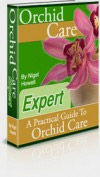Environmental Problems
Yellowing leaves: This is natural on older leaves before they die and drop off but if this is happening to younger leaves it may be an indication of several problems, over watering, under feeding or too much direct sunlight. You’ll probably have a good idea of which is most likely.
Over watering will cause your orchids roots to rot and die off, check that your pot has adequate drainage, check the potting media. Decaying potting media may prevent proper drainage and should be changed. Allow your orchids roots time to dry completely before watering them again.
If the younger leaves are developing abnormally or are mottled before turning completely yellow this may be a sign of under feeding. Buy some specialist orchid fertiliser or check that your existing fertiliser contains the proper nutrients and trace elements.
Strong direct sunlight is not good for your orchids and may cause the leaves to burn even in small amounts you can use frosted glass or net curtains to diffuse strong sunlight or if possible move your orchid out of direct sunlight.
Brown or Dying Leaf Tips: Another indication of over feeding your orchid, increase the periods of time between feeding your orchid and check the fertiliser is correctly balanced for orchids.
Limp Leaves: This can be caused by root loss through over watering, decaying potting media or that the pot is too large. Check your orchids roots, dying roots will be soft or mushy to the touch. Make sure roots are allowed adequate time to drain between watering. Decaying media should be changed as this provides a good environment for bacteria to grow and damage your orchids roots. Your orchid should be also quite tightly potted.
Orchid Not Blooming: Only mature plants should bloom. Once again, check that your orchid is not being over watered or overfed. Check the light level your orchid receives, too much and the leaves may begin to yellow and too little and they may turn darker. The night time temperature difference may also be a problem.
Orchid Fungus and Diseases
Fungal infections often suggest that the plant is already in a weakened state possibly due to low temperatures or damage. Try to maintain a good indoor temperature (between 70 and 80 degrees Fahrenheit during the day) if you live in a cold climate. Avoid watering or misting your plant with cold water and check for draughts, open windows and air conditioning could be the cause especially in an office environment. Try to avoid cuts and clean any that do occur, you can do this simply with an application of sulphur or cinnamon powder to the damaged area to seal the wound.
You can treat infected areas with a 3% hydrogen peroxide solution which you can purchase at most chemists or pharmacies. Spray over the whole plant or apply directly to the infected area.
Common Orchid Pests
Many problem orchid pests are attracted to rotted potting media and can be prevented by simply re-potting your orchid when it’s required. Many of these cause relatively little harm to your orchids and feed mostly on decaying material.
Aphids: Are a common house plant pest and are by no means limited to just orchids. They will attack new growth where the surface is thin and tender enough to allow them to feed. Aphids are easy enough to control with general insecticides.
Slugs and snails: Again these are common variety house plant pests and can hide well in potting media, appearing at night when they will chew on leaves and stems. The can usually be detected by the shiny trails they leave. Check your potting media, they are large enough to be removed by hand but they can be easy to missed, change the media if necessary.
Mealy bugs: Appear as a whitish cotton like mass and can be easily confused with Orchid Scale, but treatment is similar. Application of an insecticide over the recommended course of time should kill them but due to a long incubation period (up to 6 months) they can reappear and several courses may be required in the long run. An oil based solution can also be used to kill active bugs as it blocks their airways. Changing your orchids potting media is also advisable. When applying insecticide be sure to coat both sides of the leaves.
You’ll find most orchid problems can be solved and you’ll avoid the majority with proper care and attention.

